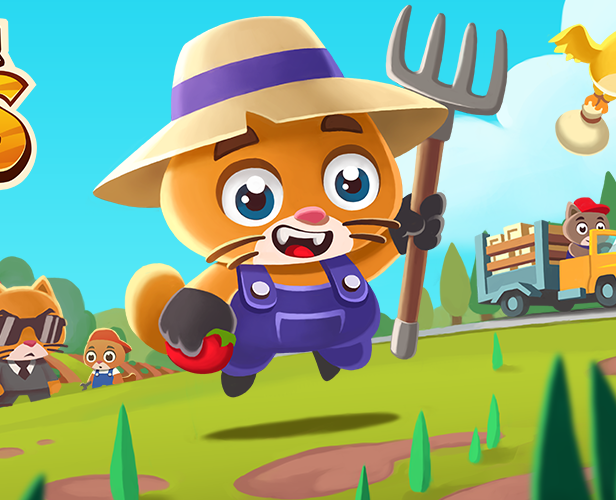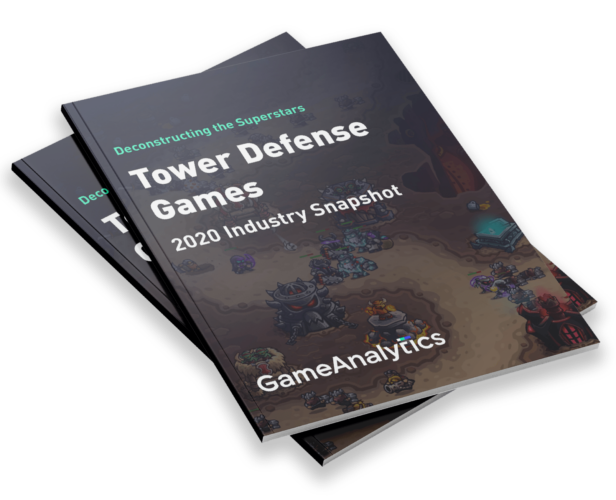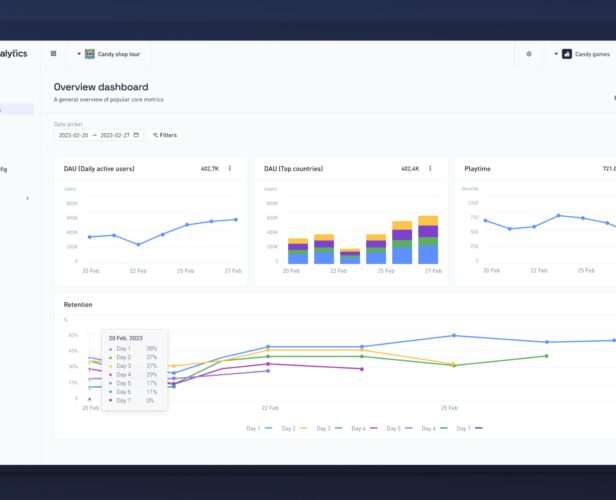Resources > All
Insights and tips about the games industry
Subscribe for gaming insights, industry reports and product updates delivered straight to your inbox.
#Marketing & Publishing
Top Tips for Choosing Hyper-Casual Publishing Partners in China
There are quite a few things a developer or publisher needs to consider before working with a Chinese publisher. Here are some of the big questions you should be asking: Would their current partners recommend them? You can ask the publisher to show you examples of the games they’ve launched, companies they work with and what results they’re getting. But that can only tell you so much. It can be extremely insightful to check who they’re already working with and contact those people directly. We recommend talking to at least two or three of the publisher’s current partners. Every developer might have had a different experience and hearing only one story might not tell you everything you need to know. Who’s on their team and how is it structured? You should find out what the publishing team looks like. Do...
#Guides
Making a Hyper-Casual Game? Here’s 5 Common Mistakes to Avoid
Editors note: This article was originally crafted by Sarah D. Vries, Content Creator at Coda Game. You can find the original piece here. The hyper-casual gaming industry is constantly evolving, requiring developers to be on top of trends and the latest gaming practices to remain competitive. Like honing any craft, it’s a constant work in progress and many studios often end up making common mistakes that can easily be avoided. Thankfully at Coda, we’ve had extensive experience working with developers and studios of all sizes. From our experience, we’ve compiled a list of the top five common mistakes that hyper-casual developers make and how best to avoid them when creating your next game. 1. Getting the difficulty of levels wrong Hyper-casual games are known for their simple nature and the ability for gamers of any level to play. One common...
#Marketing & Publishing
How to Keep Players Engaged and Coming Back to Your Idle Game
Idle games don’t involve much in the way of thinking from the player. And they don’t have an end goal – you just continue to play them, earning more in-game currency and upgrading as you go. They’re usually free to play, relying on in-app purchases and currency passes to make money. But how can you make sure that your players want to keep coming back? In this blog we’re going to tell you how to do just that, and also share some stats on engagement metrics. Why idle games appeal to both players and developers On paper, idle games sound a bit ridiculous. Why would anyone want to play a game that involves hardly any, well, playing? The numbers say different though – idle games have really high retention rates, and users keep coming back, even when they’ve been playing...
#Strategies
How to Crack the Match 3 Code?- Part 4: Project Makeover
Editors note: Originally published on February 2, 2021, by Om Tandon. You can find the original article here. There is a new Match 3 on the block and it’s taking on casual games genre with both guns blazing! You (the reader) shouldn’t act surprised, though. The previous 3 articles in this series have been consistently forecasting that any new chart busting contender in Match 3 space was highly likely to be led by fashion & make up metas which was built on what we identified as the four “Must have” key design pillars of modern day meta Match 3 games. Magic Tavern/AppLovin’s latest fashion meta based “Project Makeover” does exactly that and even more! It goes beyond the framework of Classic and Meta Match 3 subdivided by being the first in its class of Meta Heavy Match 3 aka a MHM3 Game. But more...
#Data & Analytics
New Report by Adjust and Facebook Reveals Opportunities for Developers
This month, Adjust has teamed up with Facebook to analyze the mobile app market and produce The Mobile App Growth Report. The report digs into the top trends across the industry, focusing on where there has been the most growth, and highlighting trends in emerging markets. And it looks like good news for game developers. Games keep going strong Growing like skeletons out of a mob spawner, games are the top-ranking industry this year. It looks like the surge of activity we’ve seen the last few years is showing no sign of slowing down and that there are more and more people turning to games for entertainment. Hyper-casual games push the industry forward It’s worth noting that Adjust believes that a big part of this growth is due to the hyper-casual genre, which makes sense. We’ve seen that over lockdown...
#Game Design
The Voodoo Art Manual: How to Make Effective Game Art in Hyper-casual
Editor’s note: This article was originally published by Voodoo. You can read the original on their blog here. The brand new Voodoo Art Manual is now available for all partner studios on our Publishing Platform. It contains a concrete and practical guide on how to create effective and engaging game art in hyper-casual. We know that many of the studios we work with don’t always have dedicated game artists in their teams, and that it is often created by developers using the help of existing tools on Unity. Art, however, is an essential element of your game. It makes or breaks both the clarity of your gameplay and the user’s experience. Without effective art, the success of your game lies in the balance. The Voodoo Art Manual was created to maximize your chances of success in the prototyping phase. Whether you’re an experienced...
#Marketing & Publishing
Publishing Hyper-Casual Games in China: What do you need to know first?
Should you or should you not try to launch your hyper-casual title in China? There are a bunch of rules and regulations to consider before trying to enter the Chinese market. Which are changing all of the time. Keeping up is a challenge, as we’ve seen a lot of changes over the past year – with even more coming over the next year. While bringing mid-core mobile games to China is more complicated, there’s a different process and different things to consider for hyper-casual games. There are plenty of interesting opportunities for hyper-casual developers who might not have even considered publishing in China, or perhaps just don’t know where to start. China’s mobile game market is huge The Chinese mobile market is a 25 billion USD market and it’s predicted to grow even bigger this year. Of course, the global...
#Data & Analytics
The Metrics Behind Successful Tower Defense Games
Get ready to plan your layout, as you’ve got waves upon waves of metrics coming at you. We’ve been taking a gander at Tower Defense games in our latest report, so let’s look at what the perfect set up is when developing yours. If you’d like to jump straight into the stats, download the full report. And, if you’re a keen strategist, you can dive even deeper with Benchmarks+. What’s a Tower Defense game? It’s a strategic genre where the player needs to defend their territory from increasingly large waves of enemies. Usually, the waves of mobs swarm down a path and the player must line it with traps and attacks, usually towers. The key is that the player doesn’t typically control these towers themselves. They automatically fire when an enemy approaches. Why are they popular? Tower Defense combines elements...
#Data & Analytics
Left or Right? How Data Warehouses Make it Easy to Make Decisions
Deciding between two different courses of action is perhaps the hardest part of running any business. Recently we wrote about how data warehouses can give you insights, trends and information. Everything you need to make informed decisions. But what sort of decisions do they help with? How do you actually take that insight and make practical choices? In this article, we’re going to talk through nine decisions you might need to make. And how a data warehouse can help. Why do studios and publishers use data warehouses? Most hit studios and publishers have a portfolio of games. A data warehouse brings together the data from across them all and converts it into a format they can search through. With more data, they can spot trends. Knowing the trends, they can fix bugs, optimize their ads, see which ideas perform the...
#Strategies
4 Habits any Successful Developer should pick up
Editor’s note: This article was written by Sarah D. Vries, Content Creator at Coda Games. You can find the original piece here. When it comes to developing a hit hyper-casual game, your chances for success are not entirely based on luck. Any successful hyper-casual developer can tell you that it’s a lot of hard work, trial, and error and identifying best practices that help optimize and streamline their development process. At Coda, we’ve had the pleasure of working closely with many talented developers, even having had the chance to interview those that have created hit games. From observation and conversations, we’ve come to realize that many often share the same habits and best practices that help them to increase their chances of success. Keep reading as we identify four key habits successful hyper-casual developers share and how you can employ...
#Game Design
Voodoo Talks Trends: How to Stay Ahead of the Game in 2021
Editor’s note: This article was originally published by Théophile Tabary, Publishing Manager at Voodoo. You can read the original here. As Publishing Managers at Voodoo, we often receive questions on current and future trends in hyper-casual. Trends can be difficult to navigate for studios and developers; sometimes you want to be following trends, and sometimes you want to be creating new ones. We’re here to give you some guidance on how to approach trends when creating hyper-casual games, and how to stay ahead of the game in 2021. What are trends in the hyper-casual market? The first thing to remember is that there are several different types of trends in hyper-casual. Each type contributes to the market in a slightly different way, and it is helpful to define which category your ideas or prototype fit into in the ideation and...
#Guides
Sub-Genre Snapshot: Tower Defense Games
We break down the top KPIs that Tower Defense developers should be aiming for, and reveal a few of the rising superstars that entered the market in 2020. What’s inside? Using aggregated data from our network of games, we’re dissecting the industry at a sub-genre level. All to bring you more actionable and granular insights to better your game development. Stats for key metrics Aggregated data from 134k+ games for all key metrics, including retention, ARPDAU, and more. New Superstar TD games Ranking data for over 200k+ games, with over 100k tagged with sub-genres. Secrets behind the genre A behind-the-curtain look at what makes Tower Defense games so successful.
#Marketing & Publishing
Hyper-Casual in 2021: What to Expect in Eastern and Western Markets
Hyper-casual games boomed in 2020. With so many of us confined to our homes, the mobile gaming industry saw a peak worldwide – especially in the Chinese, Indian and Brazilian markets. During the lockdowns, active users went up 200%. The average length of gaming sessions went up 20%. And hyper-casual games alone generated 1bn monthly downloads. Can these numbers remain so high? Could they go even higher? Here’s what we’re expecting to see in the market in 2021. IDFA changes will affect hyper-casual the least While IDFA still remains a question mark, the iOS changes seem unlikely to affect hyper-casual games directly. This is because the hyper-casual genre has a broader audience than other categories and targets users differently. Meanwhile, ad money could prove to be an issue due to other genres like mid-core games getting hit with the IDFA...
#Editor's pick
Game data pipeline: Building vs buying
As a large number of studios, publishers, and game developers are heavily relying on data to guide their decisions, they need to decide between building or buying. But which one is more efficient? To assist you in understanding the Total Cost of Ownership (TCO), we broke down the following key considerations: Setup requirements Cost calculation Team needs and recruitment
#Editor's pick
Mobile gaming benchmarks for Q1 2024
Uncover the industry’s performance with Q1 2024 benchmarks. Explore key metrics like retention rates and session engagement to benchmark your games against industry standards. What’s inside? Retention benchmarks for casual, classic, and mid-core games Session length benchmarks for games launched in North America, Europe, the Middle East, and Asia Session count benchmarks across 15 game genres
#Editor's pick
Grow your revenue with Xsolla Web Shop for Mobile Games
“Xsolla anticipated this seismic shift earlier this year, when we launched multiple products that are being actively used by some of the world’s largest game companies to increase profit and build closer relationships with their mobile and pc players. We’ve now combined these products and learnings into an elegant new solution called Xsolla Web Shop for Mobile Games,” said Chris Hewish, President of Xsolla. Through Xsolla Web Shop for Mobile Games, developers can expect significant revenue growth and can reach new players in new geographies previously unavailable to them. This solution solves many challenges developers face; such as discoverability, declining profit margins, lack of control over the user experience, access to localized payment methods, cross game marketing, more efficient user acquisition, effective collaboration with creators and influencers, and much more. Three industry-changing announcements make this opportunity more timely than ever:...
#Editor's pick
2023 Roblox report: Behind the data with GameAnalytics
Download a comprehensive report of Roblox player behavior and game performance based on GameAnalytics data from 2023. This report highlights critical benchmarks and insights to help Roblox creators optimize their games. What’s inside? Devices analysis Players’ daily session frequency Average revenue spent per user Session length and count benchmarks Retention benchmarks Revenue benchmarks
#Editor's pick
The Game Developer’s Handbook to Mastering Data Solutions
Data is the key to success in the ever-evolving landscape of game development. Explore this guide to transform your data into insights using our turn-key data solutions. What’s inside? Our comprehensive guide explores cost-saving strategies and real-world applications for advanced use cases. Learn how to seamlessly integrate data sources, unlock detailed player insights with Player Warehouse, access real-time data with Raw Export, and ensure data privacy compliance.
#Case study
Developing a #1 VR MMO: Ramen VR’s Journey with GameAnalytics
Discover how Ramen VR used data-driven game development to launch "Zenith: The Last City", which became the #1 bestselling game all major VR platforms—including Meta Quest/Rift, Steam and PlayStation VR.
#Editor's pick
Using AI to Supercharge Your Game Art Design
Discover how tweaking AI tool settings can help you generate varied art styles, produce better concepts, and speed up the process from prototype to final design. With AI on your team, creating unique game art has never been easier or faster.
#Editor's pick
Event Design & Tracking Guide for GameAnalytics
Learn how to create an adaptable tracking plan, enabling you to unlock richer insights and maximize the value of your data within GameAnalytics.
#Editor's pick
How studios use DataSuite to find hit games
Learn how successful publishers evaluate hundreds of games per month, to find the next hit game.
#Editor's pick
Among Us VR dev talks about how to create immersive worlds
VR is all about immersion. It’s about allowing players to lose themselves in more than just a game, but a new world. You have to build VR experiences the right way to make this happen. This goal is always top-of-mind for Schell Games. In this interview, we spoke to Schell Games’ Vice President of Product, Charlie Amis, to learn their story. “For VR, you want to make the player feel like they’re actually in the world you’ve created. This isn’t as true or a high priority in PC and console games. If people start to lose that sense of presence and immersion, then a lot of the reason they put the headset on is hurt. They want to go to another world or be someone new. So you need to help them feel like they’re really there and really that...
#Editor's pick
GameAnalytics H1 Update: New Product Improvements!
It’s been a busy time since February, when the largest update in GameAnalytics history was launched. Read on for more information about what’s changed recently, and new functionality coming to the platform very soon.
#Case study
How TapNation uses DataSuite to increase the LTV of 19 hit games by 50% in only 6 months
Smashing obstacles with Giant Rush While they’ve seen huge improvements using DataSuite across their portfolio, one game stands out in particular: Giant Rush. (And not just because the character is huge.) The title has now reached over 140 million downloads. And, through a series of A/B tests and insights from the data they collected, they’ve been able to increase the LTV by a whopping 200% over six months for this specific title. “It’s because we A/B test every day,” Philippe Grazina from TapNation says. “We ask questions like: When are players leaving the game? For example, the boss in Giant Rush. If we spot that they’re leaving at the same point every time, we know we need to make a change. Small details like that really help.” Through these granular insights, TapNation can iterate and improve on their game step...
#Editor's pick
How to Build a Data Warehouse for Games from Scratch
Over our last couple of blogs around data warehouses, we’ve explained how they let you analyze data from across your portfolio and look at what insights you can gather from them. Now, we’ll dive into how to build a data warehouse. What steps do you need to take and what resources will you need? To figure this out, we’ve rounded up the costs, steps, and tools we think you’ll need to get started. Please note, that we haven’t included the cost of running an engineering department (which you’ll need), which can end up being a lot of $$$. What do I need to get started? Before you start, you’ll need to ensure you have the right people. You’ll likely need a software or data engineer, and perhaps an architect or DevOps engineer. You’ll also need to budget for tools like...



























